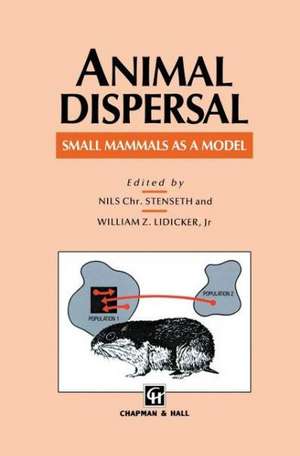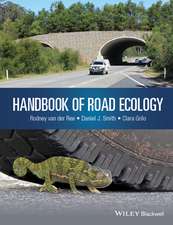Animal Dispersal: Small mammals as a model
Editat de N.C. Stenseth, W.Z. Lidickeren Limba Engleză Hardback – 31 dec 1991
| Toate formatele și edițiile | Preț | Express |
|---|---|---|
| Paperback (1) | 948.61 lei 6-8 săpt. | |
| SPRINGER NETHERLANDS – 6 oct 2012 | 948.61 lei 6-8 săpt. | |
| Hardback (1) | 954.77 lei 6-8 săpt. | |
| SPRINGER NETHERLANDS – 31 dec 1991 | 954.77 lei 6-8 săpt. |
Preț: 954.77 lei
Preț vechi: 1164.35 lei
-18% Nou
Puncte Express: 1432
Preț estimativ în valută:
182.73€ • 190.04$ • 152.91£
182.73€ • 190.04$ • 152.91£
Carte tipărită la comandă
Livrare economică 14-28 martie
Preluare comenzi: 021 569.72.76
Specificații
ISBN-13: 9780412293306
ISBN-10: 0412293307
Pagini: 365
Ilustrații: XIII, 365 p.
Dimensiuni: 155 x 235 x 22 mm
Greutate: 0.71 kg
Ediția:1992
Editura: SPRINGER NETHERLANDS
Colecția Springer
Locul publicării:Dordrecht, Netherlands
ISBN-10: 0412293307
Pagini: 365
Ilustrații: XIII, 365 p.
Dimensiuni: 155 x 235 x 22 mm
Greutate: 0.71 kg
Ediția:1992
Editura: SPRINGER NETHERLANDS
Colecția Springer
Locul publicării:Dordrecht, Netherlands
Public țintă
ResearchCuprins
One. Introductory chapters.- 1 The study of dispersal: a conceptual guide.- 2 To disperse or not to disperse: who does it and why?.- 3 The genetic consequences of dispersal.- Two. The process of dispersal.- 4. Habitat heterogeneity and dispersal: environmental and genetic patchiness.- 5 Social Factors in immigration and emigration.- Three. Patterns: cyclic versus stable populations.- 6 Patterns of dispersal in non-cyclic populations of small rodents.- 7 The role of dispersal in cyclic rodent populations.- Four. Applications.- 8 Small mammal dispersal in pest management and conservation.- Five. Looking backward and forward.- 9 Presaturation and saturation dispersal 15 years later: some theoretical considerations.- Six. Invited commentaries.- 10 Do large mammals disperse like small mammals?.- 11 The primate perspective on dispersal.- 12 A red grouse perspective on dispersal in small mammals.- 13 An entomological perspective on animal dispersal.- Seven. Appendices.- Appendix 1. Where do we stand methodologically about experimental design and methods of analysis in the study of dispersal?.- A1.1 Introduction.- A1.2 Techniques for obtaining data.- A1.3 Methods of analysis.- A1.4 Future directions.- References.- Appendix 2. Alternative approaches to the study of small mammal dispersal: insights from radiotelemetry.- A2.1 Introduction.- A2.2 Verification of dispersal.- A2.3 Description of movements.- A2.4 The location of dispersers.- A2.5 Dispersal distance.- A2.6 Dispersal frequency.- A2.7 Future studies.- A2.8 Conclusions.- References.- Appendix 3. The use of radioisotopes in the study of dispersal: with a case study.- A3.1 Introduction.- A3.2 A brief survey of radioisotope use in population studies.- A3.3 The Myllymäki-Hansson-Hoff study.- A3.4 Conclusions.- References.-Epilogue.
Recenzii
...it provides an introduction to the problems and potential significance of other animals' dispersal that is missing in other books...any student of dispersal will want this book on hand - BioScience; ...very useful for all researchers that have been studying and are planning to study problems concerning dispersal - Animal Behaviour; ...a detailed organic review of the main problems of animal dispersion. N C Stenseth and W Z Lidicker have done a praiseworthy job both as editors and authors - Ethology, Ecology and Evolution; ...this book especially useful for graduate students and others beginning research on dispersal...concise and well-organized reviews - The Quarterly Review of Biology; The book is obviously the product of a clear objective and careful planning. The mix of perspectives and styles of the two editors and the authors gives this book a dynamic and fascinating character. This collaboration by two individuals with different approaches and perspectives should provide a model for the field of small-mammal ecology. This book embodies a major advance in the study of animal dispersal. It would be outstanding material for a graduate seminar in ecology, ethology, or mammalogy, as it reveals a dynamic field at the apex of its vigor... this book is far more cohesive than typical conference proceedings. It provides fertile ground for graduate students and established researchers searching for new ideas. It is essential reading for small-mammal ecologists and strongly recommended for specialists on other taxa who are interested in dispersal.













